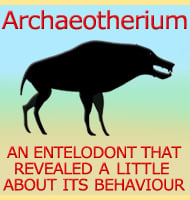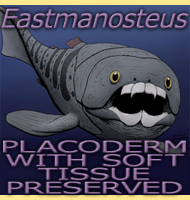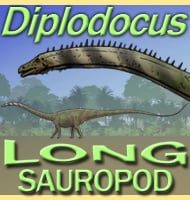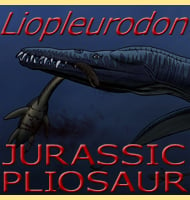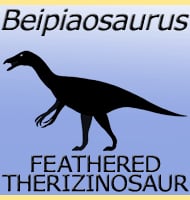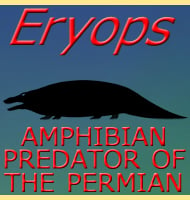Name: Coelacanth (Hollow spine).
Phonetic: See-la-canth.
Named By: Louis Agassiz - 1839.
Classification: Chordata, Sarcopterygii, Actinistia, Coelacanthimorpha, Coelacanthiformes.
Diet: Piscivore.
Size: Up to around 180 centimetres long and around 80 kg. Sometimes credited at being up to 200 centimetres long.
Known locations: Fossils known from across the world. Living specimens have been found off the coast of East Africa and Indonesia.
Time period: Devonian through to present day.
Fossil representation: Multiple fossil specimens. Coelacanths continue to occasionally be caught by fishermen
Coelacanths are one of the best known animals that today are loosely termed ‘living fossils’.
This is because while the first fossils were known as early as 1839, a living specimen was actually caught off the coast of South Africa in 1938.
Of course this discovery both shocked and surprised the paleontological community, and triggered a rethink in evolutionary theory regarding the ancestry of land vertebrates.
However before we look at the living members lets go back to the fossils so that we can get a more complete picture about these fish.
Coelacanth fossils
The first coelacanth fossil was named by Louis Agassiz in 1839, a man who specialised in studying and naming fossils of fish.
In describing the fossil Agassiz made special note of the hollow rays of the caudal fin, giving rise to the name coelacanth.
However it is important to remember that today coelacanths are actually treated as a group of fish rather than a specific genus, but all of the known genera share the same approximate form and proportions.
Coelacanth fossils do however reveal fish that are a variety of different sizes, from several centimetres to much larger.
Coelacanths are members of the Sarcopterygii class of vertebrates.
This means that as a group they are closely related to early tetrapods as well as lungfish, another group of primitive fish that have managed to survive into present times.
Lungfish are quite similar in form to coelacanths, but are known to have the ability to breathe air when out of the water, something that coelacanths as a group are believed to be incapable of doing.
Fossils of coelacanths revealed a fish that was not as well adapted for swimming as other forms, and actually had powerfully built fins that seemed to be quite muscled. This led to early palaeontologists considering that coelacanths may be ‘missing links’.
The placement of coelacanths in evolutionary theory
Evolution theory really came into the spotlight with the publication of Charles Darwin’s ‘On the Origin of Species’ in 1859 (however there were earlier similar theories before this).
This new theory of evolution was controversial because rather than having creatures just appearing upon the landscape by means of a divine creator, it stated that animals evolved from one another by a process of natural selection where successful animals adapt and change to meet new challenges.
This led to study on where life could begin and a scenario was rapidly constructed where life appeared in the oceans first due to conditions being more favourable to the creation of life.
The problem though is that there are creatures that live on the land, and in terms of evolution they must have a common set of ancestors that once lived in the ocean.
This means that at some point a creature must have developed both the ability and need to leave the water and climb onto land.
Here the early supporters of evolution began to look at lobe finned fish, but gave particular attention to coelacanths.
As mentioned above these were fish poorly adapted for fast swimming, but had limbs that could seemingly support the weight of the body on land when out of the water.
The reasons for a fish leaving the water were explained as everything from predator evasion to leaving one body of water to cross land to reach another body of water to either spawn or spread out into new waters.
The first problem was pointed out soon after this proposal in that at the time no transitional form that showed the change from coelacanths to the early amphibians existed.
However this gap was easily enough explained by supporters who said that just because the transitional forms had not yet been found, it does not mean that they did not exist.
The biggest blow for the theory would come in 1938 however when the unthinkable happened; a living coelacanth was caught by fisherman off the coast of South Africa.
This was not a fluke occurrence either and it was soon established that there were several surviving populations of them thriving in the waters of the Indian Ocean.
The discovery of living coelacanths revealed one key thing; coelacanths spend their entire lives in the water and never walk on land.
Critics of evolution jumped up and took this discovery as proof that this part of the theory and even the whole concept of evolution was wrong and that they were right, but the patience of time and hindsight has not quelled the theory but reinforced it.
The inclusion of coelacanths into this niche of evolutionary theory was a mistake, but one that was made by people who were reconstructing a theory upon a very incomplete record of fossils.
With successive discoveries, more and more forms have been found which show more lobe finned fish with strong fins (now widely regarded as being for the purposes of pushing through dense growths of underwater weeds) and earlier amphibian forms that show terrestrial developments but still an aquatic life.
The discovery that has made the most headlines however is Tiktaalik, a creature that seems to be split between being a fish and an amphibian.
The body of evidence to support the theory of evolution grows with each passing year, but today coelacanths are only a footnote that marks a temporary misdirection.
Latimeria - The living coelacanths
Because coelacanth fossils seemed to disappear from deposits at the end of the Mesozoic, popular opinion suggested that they died at the same time as the dinosaurs.
Then in 1938 Hendrik Goosen, a trawler man who captained the Neriene returned to the port of East London, South Africa with a strange looking fish that was unlike anything he had ever seen.
He contacted Marjorie Courtenay-Latimer of the museum of East London to see if she was interested in it, however the fish did not make it into port until many hours after it was caught and the skin had already turned a dark grey colour instead of the blue it had been when caught.
Courtenay-Latimer could not identify the fish either but time was running out and the only option she had to preserve it was to have it ‘stuffed’ by a taxidermist. Soon after James Leonard Brierley Smith returned from a Christmas break and upon first glance immediately recognised the fish as a coelacanth and chose the new genus name of Latimeria in honour of Coutenay-Latimer.
The full name of the species is Latimeria chalumnae (today also called the West Indian Ocean coelacanth), after the region it was caught in.
Because coelacanths were first identified from fossils the new specimen became known as a ‘living fossil’, a phrase that has since come into popular use to describe other creatures that have been around for considerable time.
Not all were convinced at the validity of the new specimen however because the bones and gills were not kept after the taxidermy, leading to some speculating that the fish had been modelled to look like a coelacanth rather than actually be one.
In 1952 supporters got the evidence they needed to silence these doubters when a second specimen was caught although at the time this was named Malania anjouanae in honour of Daniel Fran�ois Malan, the then prime minister of South Africa who was instrumental in the specimens preservation.
Further specimens continued to caught and observed throughout the twentieth century, but in 1997 another exciting find, a new species of Latimeria was discovered in Indonesia.
Found for sale at a fish market by Arnaz and Mark Erdmann, this new specimen was named Latimeria menadoensis (Indonesian coelacanth) and differed from the first species by having brown skin instead of blue.
Although not deliberately fished for like some commercial species, Latimeria continue to be caught with the specimens usually being reserved for collectors and scientific institutions.
As one might expect, Latimeria are very primitive in physical form, with perhaps their most archaic feature being the presence of a notochord (a pressurised tube) rather than a developed spine.
Most fish today have a spine composed of lots of vertebra (even sharks have vertebrae made from ossified cartilage).
Latimeria also have tube shaped hearts that are different to modern fish genera. Latimeria are also not thought to be great problem solvers since the actual brain only takes up 1.5% of the internal volume of the brain case where it is housed (the remainder is filled with fat).
Latimeria are deep water fish that are more active at night.
During the day they retreat to the shelter of caves and crevices of submerged rock formations.
Populations of Latimeria are known from across the Indian Ocean where such submerged habitats occur, with one such location being near the Comoros Islands that lie between Northern Mozambique and Northern Madagascar (Latimeria chalumnae is also sometimes more commonly known as the Comoro coelacanth).
By night they leave their retreats and hunt for other marine creatures such as fish which are themselves sheltering for the night.
Latimeria have large eyes that are adapted to pick-up blue wavelengths of light (blue is one of the few wavelengths that penetrates into deep water) and is probably one of the reasons why they shelter in dark areas during the day so that they are not overwhelmed by the increased light).
However researchers believe that Latimeria may also have an electro-receptive ability similar to how sharks hunt that allows them to zero in on hidden prey in the dark.
Latimeria come in both bright blue and brown forms with a speckling of lighter spots across the body.
However this colouring is only seen in living or recently caught specimens and after death and possibly exposure to the air the colour quickly fades to a dark grey.
The spots on a Latimeria seem to have a completely random spread that can differ greatly amongst individuals, which has led to speculation that Latimeria may be able to recognise one another, especially when they congregate in submerged caves.
Some scientists have also speculated that Latimeria may be able to communicate with each other via electro-receptive pulses.
Although social enough to gather together during the day, Latimeria have been seen to shy away from physical contact with one another.
Latimeria also seem to have a shy disposition and shy away from anything they perceive to be a potential predator.
For such a large fish, Latimeria has proportionately small fins and a tail fin that is split into three parts called ‘lobes’.
These fins are supported by hollow spines that were Agassiz’s original inspiration for the name coelacanth when he first looked at the fossils.
Earlier studies depicted the coelacanth as a fish that was not as well adapted to swimming as other fish, but the living Latimeria has revealed a very special method of locomotion.
Although Latimeria are capable of propelling themselves by their tail, they seem to prefer drifting upon currents and using their fins just to steer and orient themselves as they drift.
This is a highly energy efficient form of locomotion and while Latimeria may not be the fastest fish in the ocean, it seems to be a successful survival tactic that has served them for several hundred million years.
Latimeria have also been seen to swim belly up and even do ‘head stands’ on the ocean floor as they drift with no ill effects being noted by the observers.
Latimeria seem to be all about conserving energy as the deeper waters that they prefer to live in never get as warm as the surface layers that are warmed by the sun.
In an ectothermic (cold-blooded) organism like a fish, this reduces the metabolic rate which means that they can survive upon less food.
Also staying in caves means that coelacanths can stay out of the currents that use at night time so that they can just float in the water without expending energy swimming to maintain position.
Because Latimeria are adapted to live in deeper high pressure waters they do not do well in aquariums where the water cannot be maintained at the same pressures as the water at the depths that they inhabit.
Like many other deep water organisms that have been transferred to an aquarium for study, Latimeria typically do not live for more than a few hours.
Latimeria are not considered to be under direct threat from commercial fishing because they are considered to be a very poor food source.
This is because Latimeria flesh has a much higher concentration of oils, wax, and urea amongst other compounds that are indigestible by humans.
As such these compounds pool and collect inside the digestive system until they are eventually passed out in liquid form.
Fisherman who catch a Latimeria today usually only keep it for sale to a collector or scientific body that might be interested in studying the specimen, since Latimeria have gained a reputation amongst consumers as a fish to avoid.
It is uncertain if this cocktail of oils and waxes helps to prevent them being attacked by predators, but some Latimeria have been observed with shark bites to their bodies.
However the fact that these fish survived to be seen by people may indicate that sharks also find them distasteful since sharks will sometimes ‘taste’ what they think is food by biting or mouthing at it.
Also if Latimeria do hunt and/or communicate with each other by elctro-receptive pulse then these signals might confuse a sharks own electro-receptive system into thinking the Latimeria is a fish in distress and as such a viable target, leading the shark to a mistaken attack.
However deep sea trawling may still be having an indirect impact upon Latimeria since this is an indiscriminate method of fishing that drags up all kinds of fish and other animals, including those that are not desired like Latimeria.
Over use of this method can also leave extensive areas of ocean barren of life as the other organisms that make up the ecosystem are fished out to the point where they disappear.
This upsets the balance and previously stable populations of all creatures, not just Latimeria, can crumble and collapse to the point where they too disappear because the ecosystem that supported them no longer exists.
Because Latimeria are so rare already, it is difficult to ascertain specific population numbers and geographic ranges without them already getting caught in fishing nets.
Something that all people can agree upon however is that it would be incredibly sad if coelacanths could survive for some four hundred million years to just be wiped out within a few decades after their rediscovery by mankind by over fishing.
What else has survived?
The 1938 discovery of a living coelacanth caused people to ponder what else might have survived the extinction events that mark major declines in animal species across the globe.
Indeed the Permian–Triassic extinction event was a particularly bad one with an estimated ninety-six per cent of all marine creatures becoming extinct, yet the coelacanths survived this, possibly due to their energy efficient lifestyle which meant they did not need to eat as much as other creatures that were disappearing.
Popular fiction would have us believe that the great marine reptiles of the Mesozoic like Plesiosaurus and Mosasaurus might have survived in small populations as well as the giant shark C. megalodon.
However the reality is often less spectacular than fiction depicts it to be and any surviving creatures are highly unlikely to be the giant predators of old due to their survival requirements (i.e. larger or greater amounts of prey).
In short you are actually spoilt for choice when it comes down to identifying creatures that lived millions of years ago and yet are still represented today.
In terms of fish, hagfish and lungfish are still present in the worlds waters today, as well as sharks such as the frilled shark (Chlamydoselachus sp.) and goblin shark (Mitsukurina owstoni), although there is still confusion between this and the shark Scapanorhynchus.
Horseshoe crabs are armoured arthropods that are roughly as old as coelacanths yet they can still be seen climbing onto shorelines to spawn.
Velvet worms (of the Onychophora phylum) that have today become quite popular in the pet trade first entered the fossil record over five hundred million years ago and are commonly found hunting in the moist undergrowth’s of tropical forests today.
Other kinds of animals such as amphibians like frogs, and reptiles like lizards, snakes, turtles and crocodiles also lived when the dinosaurs where roaming the land (in fact some like the crocodile Deinosuchus actually attacked them) and these too have survived in what are roughly the same form for all this time.
Mammals and even birds that were once thought extinct have occasionally been found to have survived in small populations and it is realistically only a matter of time before the next ‘lost animal’ is rediscovered by man.

